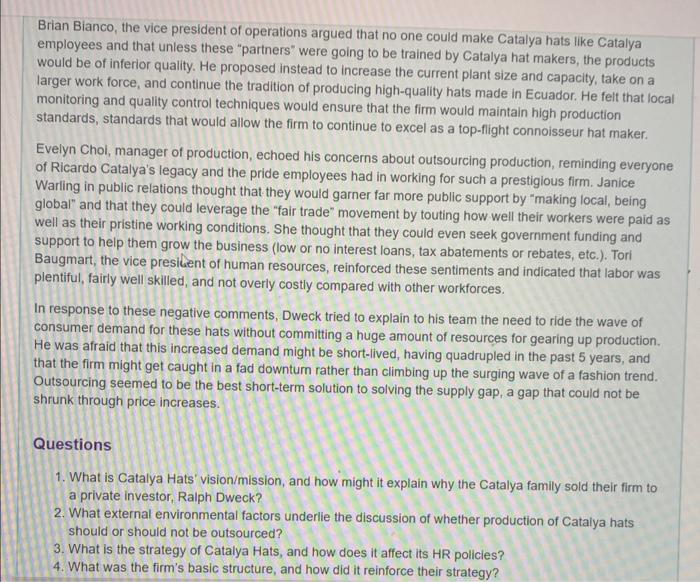Catalya Hats, a millinery company, began from a simple design of a Panama hat in Ricardo Catalya's home in Ecuador. Mr. Catalya had no idea that when he created his first Panama hat in 1906 to protect himself from the sun, it would become an iconic fashion classic. His hats were crafted from the finest natural toquilla straw fiber; no two fibers were the same. In fact, each hat had its own character because the materials were different in shape and color. Toquilla comes from a straw plant and cannot be woven by a machine; it can only be woven by hand. Depending on the weave count, one hat could take anywhere between 1 week to 3 months to manufacture. It did not take long for many powerful businesspersons and celebrities from the United States to take recognition of these handcrafted pieces. The company's strategy was to become a globally integrated quality hat company. For over 100 years, the industry has praised the company, and helped the company raise its annual revenue to $25.5 million by 2006 . Nearly all of the top managers started their careers with the firm and had worked their way up to their current positions. The firm's practice, started by its founder, was for all employees to learn the business from the ground up, starting with working on the production line assisting the hat makers (regardless of their actual field of expertise) and then rotating through every job dealing with hat production and distribution including actual hat making. This approach to employee training ensured that everyone in the firm, regardless of their specific tasks and responsibilities, had a personal connection to not only every job performed but also to most of the people who performed the jobs. The company's accomplishments were due in no small part to its cross-functional corporate structure, a structure that reinforced egalitarian decision making. By definition, the company's team or project members came from more than one functional area of the company, working together toward a common goal and a common bond: a love of hats. This structure ensured that the work groups were able to carry out the company's mission of making every hat a unique experience. Catalya's organizational culture was familybased and family-driven and embodied through the managers' and emplovees' work attitudes and behaviors. structure that reinforced egalitarian decision making. By definition, the company's team or project members came from more than one functional area of the company, working together toward a common goal and a common bond: a love of hats. This structure ensured that the work groups were able to carry out the company's mission of making every hat a unique experience. Catalya's organizational culture was familybased and family-driven and embodied through the managers' and employees' work attitudes and behaviors. The top-level managers were the leaders who set and implemented these values and beliefs as well as how an employee should be treated; they role-modeled how an employee should perform when representing the firm both within and without. The firm finally maxed out its production capacity at the turn of the 21 st century, stalling the family's plans for international growth and expansion. Although profitable, the family did not have the financial wherewithal to support a sizable plant investment and so continued focusing just on process and production improvements through technological innovation. In 2016, the firm was reluctantly sold to a private investor, Ralph Dweck, who had the capital needed to expand the name and brand. An essential part of the purchasing agreement was that Dweck agreed to retain the current employees and staff for a minimum of 2 years and that he would remain true to the quality and traditions of the firm. Dweck understood that his new staff may not see or agree with his "big picture," his vision for international growth and expansion, and hoped that he could move them out of their "familial" surroundings and transition them into a more corporate, professional milleu and mindset. At the first major executive meeting, Dweck rolled out his plans to enter into new international markets and distribution channels. Everyone seemed onboard with these growth plans until Dweck discussed the need to find international business partners in order to expand the firm's operation. These partners, specifically firms with innovative technology and excess production capability, would dramatically increase the firm's production capacity while leveraging Catalya's good name. Some form of outsourcing of production seemed to make the most sense to Dweck, given the limited financial investment required. Nonetheless, his proposal recelved opposition from many of the top managers within the firm. Brian Bianco, the vice president of operations argued that no one could make Catalya hats like Catalya employees and that unless these "partners" were going to be trained by Catalya hat makers, the products would be of inferior quality. He proposed instead to increase the current plant size and capacity, take on a Brian Bianco, the vice president of operations argued that no one could make Catalya hats like Catalya employees and that unless these "partners" were going to be trained by Catalya hat makers, the products would be of inferior quality. He proposed instead to increase the current plant size and capacity, take on a larger work force, and continue the tradition of producing high-quality hats made in Ecuador. He felt that local monitoring and quality control techniques would ensure that the firm would maintain high production standards, standards that would allow the firm to continue to excel as a top-flight connoisseur hat maker. Evelyn Choi, manager of production, echoed his concerns about outsourcing production, reminding everyone of Ricardo Catalya's legacy and the pride employees had in working for such a prestiglous firm. Janice Warling in public relations thought that they would garner far more public support by "making local, being global" and that they could leverage the "fair trade" movement by touting how well their workers were paid as well as their pristine working conditions. She thought that they could even seek government funding and support to help them grow the business (low or no interest loans, tax abatements or rebates, etc.). Tori) Baugmart, the vice presilent of human resources, reinforced these sentiments and indicated that labor was plentiful, fairly well skilled, and not overly costly compared with other workforces. In response to these negative comments, Dweck tried to explain to his team the need to ride the wave of consumer demand for these hats without committing a huge amount of resources for gearing up production. He was afraid that this increased demand might be short-lived, having quadrupled in the past 5 years, and that the firm might get caught in a fad downturn rather than climbing up the surging wave of a fashion trend. Outsourcing seemed to be the best short-term solution to solving the supply gap, a gap that could not be shrunk through price increases. Questions 1. What is Catalya Hats' vision/mission, and how might it explain why the Catalya family sold their firm to a private investor, Ralph Dweck? 2. What external environmental factors underlie the discussion of whether production of Catalya hats should or should not be outsourced? 3. What is the strategy of Catalya Hats, and how does it affect its HR policies? 4. What was the firm's basic structure, and how did it reinforce their strategy? Questions 1. What is Catalya Hats' vision/mission, and how might it explain why the Catalya family sold their firm to a private investor, Ralph Dweck? 2. What external environmental factors underlie the discussion of whether production of Catalya hats should or should not be outsourced? 3. What is the strategy of Catalya Hats, and how does it affect its HR policies? 4. What was the firm's basic structure, and how did it reinforce their strategy? 5. How did the firm's culture support their strategy










